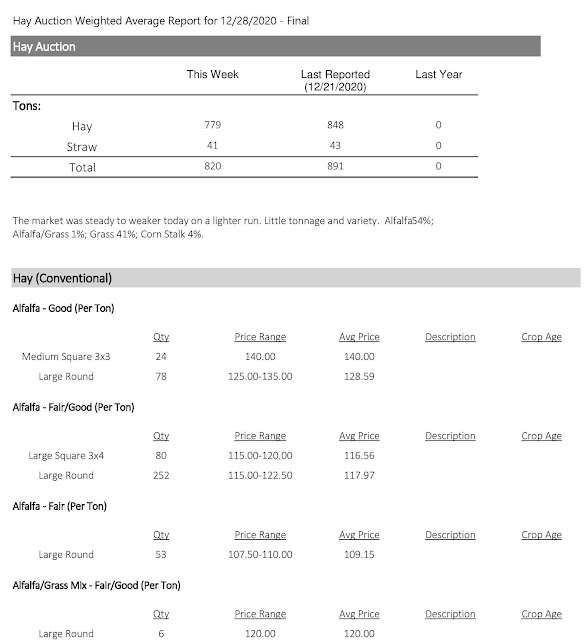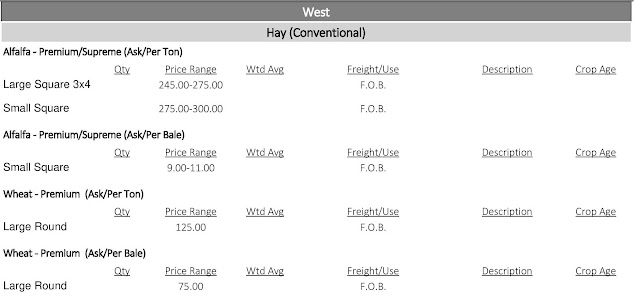Wednesday, December 30, 2020
State-By-State Hay Summary
Colorado—In the Dec. 17 report, compared to last week, trade activity light on moderate to good demand for feedlot and dairy hay. Trade activity light on good demand for stable and farm/ranch quality hay. Northeast Colorado trade activity moderate. Southeast Colorado trade activity moderate on good demand on stable quality hay. Trade inactive in southwest, San Luis Valley, mountains and northwest Colorado areas. The next available report will be Jan. 7, 2021.
Kansas—In the Dec. 22 report, hay market prices were steady, demand remained strong and movement was only 105 tons less than the previous week. Alfalfa continues to strengthen across the state and is hard to find, according to contributors in the southwest. Due to the holidays, next report will be issued Jan. 5, 2021.
Missouri—In the Dec. 17 report, the supply of hay is moderate, demand is light to moderate and hay prices are mostly steady. Colder weather spread over the state this week just days ahead of the official start of winter. There is a continued uptick in hay interest with each passing week. Many are feeding now as there was very little grass stockpiled due to the dry fall. Many in the state seen a touch of snow this week but nothing to cause any major problems just a dusting in a few areas. There is some hay starting to move but a lot of window shopping for the most part.
Montana—In the Dec. 17 report, compared to the last week, hay sold generally steady. Ranchers continue to buy hay for winter needs and supplies continue to tighten. Hay supplies along the Wyoming border are tight as many loads continue to sell out of southern Montana into Wyoming. Winter weather has been mild across much of the state which has helped curb feeding demand. While many locations remain open some ranchers are still supplementing hay as regrowth is limited due to the drought this summer. Drought conditions remain unchanged from last week. Due to the holidays this report will not be published again until Jan. 8, 2021.
Nebraska—In the Dec. 17 report, compared to last week, all reported forages sold steady. Demand was good. Some hay staying in the local trade area with some going to out of state buyers. Light snow in some areas of the state should be mostly melted by week’s close with day time highs in the mid 40s to low 50s. Next available report will be Jan. 7, 2021.
New Mexico—This report will resume in the spring of 2021.
Oklahoma—In the Dec. 17 report, compared to two weeks ago, hay trade is starting to pick up as winter weather approaches, most producers are hoping for a turnaround after the new year. Recent snow storms including much needed moisture has came across the trade over the last two weeks. Demand remains light to moderate. Until hay trade becomes more active this will be a bi-weekly report.
South Dakota—In the Dec. 18 report, compared to last week, high quality alfalfa steady, no comparison available for other qualities and types of hay. Moderate demand for hay currently as the weather remains to be very mild and ground conditions are dry. The need for supplemental feeding has been greatly reduced as beef cows remain turned out. The forecast looks for more of the same, without any snow chances. Next available report will be Jan. 8, 2021.
Texas—In the Dec. 11 report, compared to the last report, hay prices are firming up in all regions, as the higher quality hays are becoming more scarce. There are still large quantities of off grade hay on the market. Temperatures have been abnormally mild for this time of year. According to the U.S. Drought Monitor, drought conditions have intensified and expanded in the Panhandle and Central Texas where both long and short-term precipitation shortfalls exist. Due to limited sales and price changes this report will be released bi-weekly until more volumes of hay is moving. The next report release will be Dec. 23.
Wyoming—In the Dec. 17 report, compared to last week all reported forage sold fully steady. Demand was very good. Contacts continue to get call from people looking for hay for the winter feeding needs. Very light snow across the state with normal wintery chill to the air. A slight warm up is in the forecast for next week. Next available report will be Jan. 7, 2021.
Tuesday, December 29, 2020
Monday, December 28, 2020
Hay Market Demand and Price Report for the Upper Midwest
Demand and Sales Comments
With the holiday season there are limited hay auctions this past week, so data was collected from the previous week. Hay market continues on a steady trend with quality dairy hay supporting the market. Lower quality round bale hay prices are slipping as winter begins. If you need forage or have forage to sell or straw, connect to the Farmer-to-Farmer webpage at http://farmertofarmer.uwex.edu/. You may contact your local county agriculture educator if you need help placing an ad. There is no charge for the service.
Straw prices are for oat, barley, or wheat straw. Straw prices remain steady. Quality has a great impact on straw prices. Small square bales averaged $4.29 a bale (range of $3.00 to $6.00). Large square bale straw averaged $42.00 per bale (a range of $20.00 to $72.00). Large round bale straw averaged $37.00 per bale (a range of $20.00 - $50.00).
In Nebraska, all forages sold steady with good demand. In Iowa, supply is strong, demand is lighter, and prices were mostly steady.
In South Dakota, there was a large run on sale day. Alfalfa quality was good and market was steady to weaker.
In Missouri, there is an uptick in hay interest. Hay supply is moderate; demand is light, with steady prices.
In Southwest Minnesota, prices were steady with a limited supply of quality hay at the market.
In Kansas, hay market prices are steady, demand remained strong, and movement was less with holiday at the end of the week.
In Wisconsin, prices are steady with strong demand for dairy quality large square bales. There is less demand for lower quality round bales.
Wednesday, December 23, 2020
State-By-State Hay Summary
Colorado—In the Dec. 10 report, compared to last week, trade activity light on moderate to good demand for feedlot and dairy hay. Trade activity light on good demand for stable and farm/ranch quality hay. Northeast Colorado trade activity moderate, mostly on stable hay, farm and ranch hay, with little activity on dairy hay. Southeast Colorado trade activity moderate on good demand on stable quality hay. Trade activity moderate in the San Luis Valley on hay going to out of state dairies. Trade activity light on good demand for southwest Colorado on stable hay. Trade activity moderate on good demand in the mountains and northwest Colorado areas for stable and retail hay.
Kansas—In the Dec. 15 report, hay market prices were steady, demand remained strong and movement was down a bit. Alfalfa continues to strengthen, across the state, and is hard to find according to contributors in the southwest. Precipitation was scant for most areas, with a few exceptions of locally heavier snows.
Missouri—In the Dec. 10 report, the supply of hay is moderate, demand is light to moderate and hay prices are mostly steady. The state saw some fairly large temperature swings this week with some unseasonably warm days. Lack of moisture as of late however has prevented any mud so that is perhaps one bright side. Hay feeding and movement is slowly increasing as the days pass. Several of the neighboring states to the west, which have been very dry, are seeing much more active markets and lower supplies especially of higher quality hay. High grain cost is also affecting the feasibly of supplementing lower quality forage as well.
Montana—In the Dec. 11 report, compared to the last week, hay sold steady to $10 higher. Hay saw slightly increases in price this week as ranchers continue to buy hay for winter needs. Round supplies are getting tight and prices have been converging with square prices over the last couple weeks. Several producers are currently selling rounds and squares of the same quality for the same price. The weather has been very mild over the past few weeks which has helped curb the need to feed cattle. Hay continues to ship south into Wyoming and some into Colorado, especially out of locations south of I-90. This continues to eat away at available supplies. Drought conditions fell over the last few weeks. Currently 32.02% of the state is in moderate drought or worse.
Nebraska—In the Dec. 10 report, compared to last week alfalfa sold steady to $5 higher. Ground and delivered hay, dehydrated pellets and grass hay sold steady. Local and out of state demand was good. Quite a few loads of hay were bought this week as dry weather pattern prevails. Some cattlemen continue to buy hay just incase they have to feed their cow herds a little longer than normal next spring.
New Mexico—This report will resume in the spring of 2021.
Oklahoma—In the Dec. 3 report, compared to two weeks ago, hay trade remains at a somewhat slow pace, most producers are hoping for a turnaround after the new year. Recent moisture and above average expected temperatures has wheat pastures in good grazing conditions and cow-calf operators extending there pasture grazing and little need for new hay until a hard freeze hit the trade area. Demand remains light to moderate.
South Dakota—In the Dec. 11 report, compared to last week, alfalfa hay mostly, grass hay not tested, straw and corn stalks not tested. Very few reported sales this week. Very mild weather is continuing across the trade region which is lessening the need for supplemental feeding of beef cows. Good demand remains for dairy hay, light to moderate for other types of hay. The open weather is allowing beef cows to graze corn stalk fields East River while West River cows run out on grass without the need for supplemental hay.
Texas—In the Dec. 11 report, compared to the last report, hay prices are firming up in all regions, as the higher quality hays are becoming more scarce. There are still large quantities of off grade hay on the market. Temperatures have been abnormally mild for this time of year. According to the U.S. Drought Monitor, drought conditions have intensified and expanded in the Panhandle and Central Texas where both long and short-term precipitation shortfalls exist. Due to limited sales and price changes this report will be released bi-weekly until more volumes of hay is moving. The next report release will be Dec. 23.
Wyoming—In the Dec. 10 report, compared to last week, all reported forage products sold steady. Demand was good to very good for hay to stay in the local trade area. Dry weather continues and many livestock owners continue to procure part loads and load lots of hay. An abrupt weather change was recorded Dec. 10 as temperatures dropped from 60s to the mid 30s overnight.














































